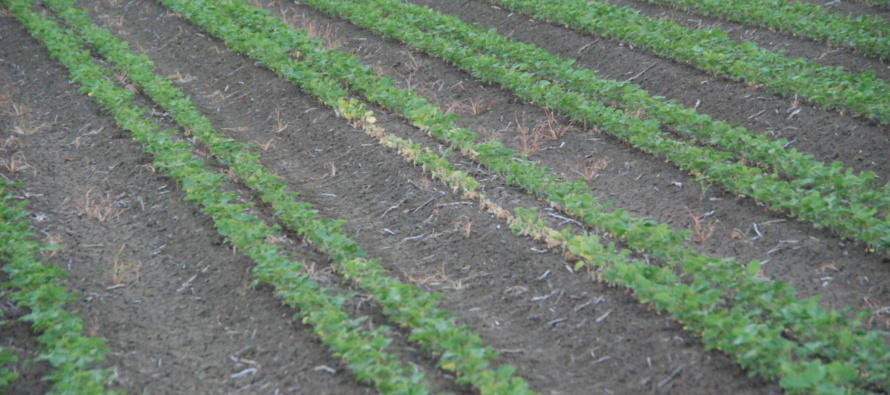Soybean Disease Update: May 19, 2018

Related Articles
- 2010 Soybean And Corn Variety Trial Data 3
- Rice Variety Trial Results For 2010, Plus Rice Research Report 0
- Evaluation of Peanut Prescription Rx Program in Mississippi 0
Latest Tweets

Southern blight can kill seedlings in a row or in more random situations represented by scattered plants.
Calls regarding the observation of root diseases feel a little earlier than normal this year.
Young soybean plants killed in small groups, or along a planted row are a common symptom associated with southern blight (see photo at left). Southern blight can occur in any soil class; however, this year in particular the greatest number of calls have been associated with heavier soils. In the past, southern blight was a greater issue on lighter soils. The best diagnostic characteristic associated with the disease is the
white, ropey fungal mycelia that grows on the stem right at the soil line or immediately below the soil line on the dead, dessicated seedling plants. Normally, once observed the disease does not spread to healthy plants. In fact, in those areas where dead seedlings are observed, the healthy plants may appear to have some limited symptoms on the crown or stem just below the soil line without the white fungal growth. As seedling stems become woodier the plants appear to become more tolerant to the fungus. Normally, sclerotia are formed at the soil line on dead plants. However, it appears this year that a general lack of moisture over the past week in some locations has reduced the formation of sclerotia. In situations where sclerotia are present these will appear as small white, to cream-colored round, hardened objects at the soil line and on dead plants can progress up the stem.
No soybean varieties are resistant to the disease; however, it is possible there are differences in sensitivity to the fungus between commercial varieties.
Taproot decline (TRD)
A limited number of fields in the south Delta have been observed to contain a relatively small number of plants infected by the taproot decline fungus. The fields observed on Tuesday (May 15, 2018) all have a prior history of the disease. Early in the season the symptoms associated with this particular disease are difficult to distinguish from several diseases as well as other maladies. In early vegetative growth stages, the first true leaves can be observed to take on a mottled, almost tiger-striped pattern. Plants removed from the soil tend to have a dry-rotted taproot and the appearance of black fungal growth that appears more like the root was dipped in black ink. Taproot decline generally presents itself with a scattered appearance early in the season. However, in field situations with a continued history of the disease, small clumps of 2-3 plants may be common. In general, the plants observed this week were V2-V3, which marks the youngest growth stage that I have observed since initially identifying this disease. At present, no management practices are available. However, research trials are currently underway in Arkansas, Louisiana and Mississippi to consider the role of in-furrow fungicide applications as well as seed treatments at managing the disease. But, it will likely be several years before significant progress is made as little appears to be effective on this particular disease.

Root symptoms associated with taproot decline on young soybean seedlings. Not the dry-rotted taproot that broke when seedling was removed from the soil profile.
For the most up-to-date information regarding the observation of diseases in the Mississippi crop system please follow me on Twitter @baldpathologist.






Let me tell You a sad story ! There are no comments yet, but You can be first one to comment this article.
Write a comment